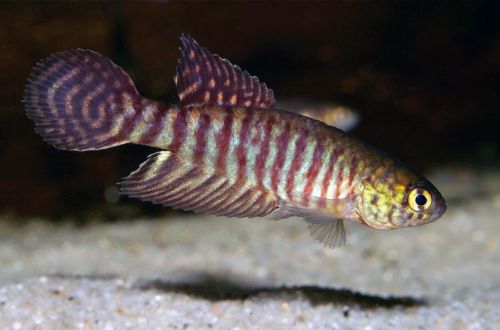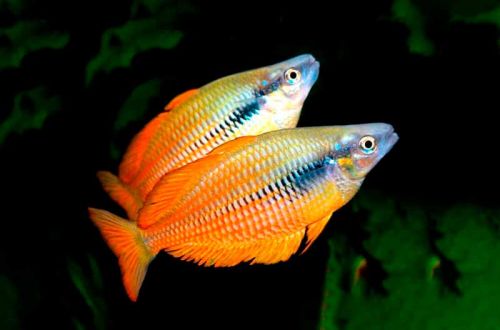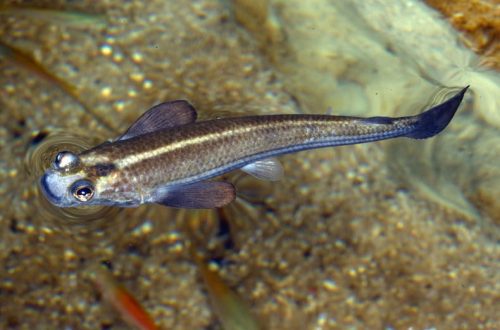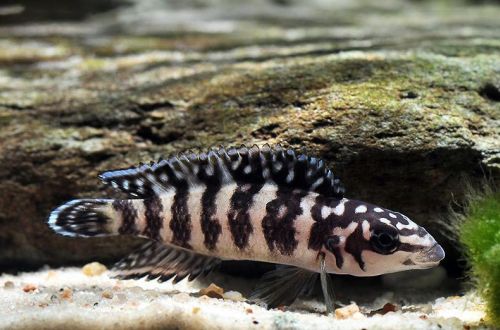
Myers fish
The Myers fish, scientific name Simpsonichthys myersi, belongs to the Rivulidae family. The original striped fish is named after two American scientists at once. The first is Charles Jay Simpson, whose name is included in the scientific Latin name. The second is George Sprague Myers. The fish was discovered and included in international catalogs relatively recently, only in 1971.

Contents
Habitat
It comes from small rivers in the Amazon basin, flowing through Brazil. They live in shallow water bodies, streams and wetlands, which are fed mainly by rainfall and are prone to periodic drying. So, for several months (July-November), almost every year, the habitat of Myers fish completely dries up. Adult fish die, and the eggs survive in the thickness of the silty soil, with the advent of the rainy season, fry appear from them.
Description
Miniature slender fish, have an elongated body and lush fins. The dorsal and anal fins are pointed, the tail is rounded. There is a pronounced sexual dimorphism. Males are somewhat larger, brownish-yellow or greenish-blue in color with 10–15 dark crimson or dark brown vertical stripes. Females are painted in light brown shades, the body pattern consists of 9–12 wide dark stripes.
Food
They prefer meat products in the form of live or frozen food. In a home aquarium, the optimal diet consists of bloodworms, daphnia, mosquito larvae, coretra (white-faced mosquitoes), etc. Feed 2-3 times a day in an amount eaten in 3-5 minutes. Leftover food should be removed from the aquarium to prevent contamination of the water.
Maintenance and care
The minimum tank size for a pair of fish is about 40 liters. The design of the aquarium is equipped taking into account the characteristics of the reproduction of this species. As a soil, plastic containers are used, filled with a dark soft substrate based on peat or coconut fiber. Containers should be easy to remove from the aquarium. As a decor, you can set some volumetric background. Plants are preferred floating, for example, two large bunches. Do not allow complete overgrowth of the entire surface of the water. Of the equipment, a simple sponge filter, heater, aerator and lighting system are sufficient. Adjust the equipment so that it does not create excessive water movement (this applies to the filter and aerator), Myers fish do not tolerate strong and medium currents.
Maintenance consists of a weekly replacement of part of the water with fresh water, usually 15 to 30% of the total volume is renewed, it depends on the number of residents and the size of the tank. As necessary, the glass should be cleaned of organic deposits.
Behavior and Compatibility
The best option for keeping is a species aquarium of a harem type, where there are 2–3 females per male. Males individually compete with each other, arranging serious skirmishes. Other types of fish are not recommended.
Breeding / breeding
As described above, in their natural habitat, fish live only one season, before the water bodies dry up, they have time to lay eggs in the ground and die. Eggs are stored until the start of the wet period.
In a home aquarium, you can increase the lifespan and up to two seasons and get offspring every year. In June, the water level is gradually reduced and at the same time the temperature is lowered to 21–23°C, this serves as a signal for spawning. The female lays eggs directly into the ground, which is subsequently removed along with the container. Then the temperature in the aquarium is raised to normal values and the fish continue to live on.
Meanwhile, the container with soil and eggs is placed in a dark place and stored at the same air temperature of 21-23°C for 2-4 months. Then the substrate is placed in a tank of water and after a while fry appear. They grow very quickly and become sexually mature in a month.
The unique feature of reproduction makes it possible to transport eggs by regular mail during the warm season.
Fish diseases
They show high disease resistance. The threat lurks for eggs if they are stored in humid conditions, there is a possibility of mold formation. Read more about symptoms and treatments in the Aquarium Fish Diseases section.





